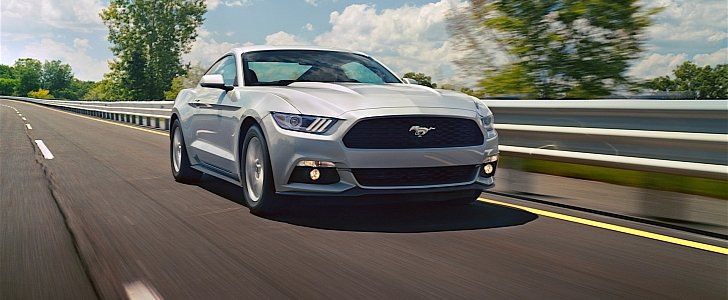Motor Trend published an odd report on their website, in which they found that EcoBoost Mustangs got slower over time, and are waiting for an official explanation from the Blue Oval.
As the American magazine reports, its editors tested four versions of the Ford Mustang EcoBoost over a period of 21 months.
Every test involved measurements with particular instruments, and all of them were done with the SAE J1349 standardized corrections. These corrections are essential to correct variations in barometric pressure, temperature, humidity, and other factors that might influence performance.
As Motor Trend explains, once the corrections have been performed, all of the tested cars are on an equal playing field, and only their individual characteristics and performance separate one from another. Their first test with the latest Mustang was in September 2014. They tested another model in February 2015.
Their first question marks came in December 2015, when they tested an EcoBoost Mustang borrowed from Automobile Magazine’s long-term test. The vehicle had the Performance package, but was slower than the first two Mustangs they had tested, even though it should have been faster to 60 mph (96 km/h). Instead, it was 0.4 seconds slower than both the manual and the automatic, both without the Performance package.
Finally, in March 2016, Motor Trend reviewed another Mustang EcoBoost, again with the six-speed manual and the Performance package. It was slower than all the EcoBoost Mustangs they had tested, requiring 6.3 seconds to reach 60 mph (96 km/h), making it 0.3 seconds slower than the car tested in December 2015, and 0.7 seconds slower than the first Mustang EcoBoost with a manual gearbox drove by the magazine.
At first, the editors believed the Performance package’s 3.55 differential gear was to blame, as it was “shorter” than the standard 3.31. The difference between the two was that the vehicle redlined in second gear before reaching 60 mph with the 3.55 differential, thus needing a shift to third and losing time.
Once the car passed 60 mph and was engaged in a quarter-mile race, for example, the Performance package had an advantage. The two Mustang models with the Performance package also had a sort of “glitch” while upshifting. According to the road test editor, the throttle response would lag when the clutch was released, slowing down performance.
Motor Trend believes that this is the reason why the two Mustangs with the Performance package were slower than the rest of the cars they tested. The traction control and stability control systems were off, so this was not an electronic intervention to secure traction.
Ford representatives explained that the first Mustang driven by Motor Trend was a prototype model, as they drove it in September 2014. Some minute changes in “calibration” have been made since then, the carmaker's reps explained. However, Ford officials did not clarify for MT why they think that the registered performance figures were diminished.
Every test involved measurements with particular instruments, and all of them were done with the SAE J1349 standardized corrections. These corrections are essential to correct variations in barometric pressure, temperature, humidity, and other factors that might influence performance.
As Motor Trend explains, once the corrections have been performed, all of the tested cars are on an equal playing field, and only their individual characteristics and performance separate one from another. Their first test with the latest Mustang was in September 2014. They tested another model in February 2015.
Their first question marks came in December 2015, when they tested an EcoBoost Mustang borrowed from Automobile Magazine’s long-term test. The vehicle had the Performance package, but was slower than the first two Mustangs they had tested, even though it should have been faster to 60 mph (96 km/h). Instead, it was 0.4 seconds slower than both the manual and the automatic, both without the Performance package.
Finally, in March 2016, Motor Trend reviewed another Mustang EcoBoost, again with the six-speed manual and the Performance package. It was slower than all the EcoBoost Mustangs they had tested, requiring 6.3 seconds to reach 60 mph (96 km/h), making it 0.3 seconds slower than the car tested in December 2015, and 0.7 seconds slower than the first Mustang EcoBoost with a manual gearbox drove by the magazine.
At first, the editors believed the Performance package’s 3.55 differential gear was to blame, as it was “shorter” than the standard 3.31. The difference between the two was that the vehicle redlined in second gear before reaching 60 mph with the 3.55 differential, thus needing a shift to third and losing time.
Once the car passed 60 mph and was engaged in a quarter-mile race, for example, the Performance package had an advantage. The two Mustang models with the Performance package also had a sort of “glitch” while upshifting. According to the road test editor, the throttle response would lag when the clutch was released, slowing down performance.
Motor Trend believes that this is the reason why the two Mustangs with the Performance package were slower than the rest of the cars they tested. The traction control and stability control systems were off, so this was not an electronic intervention to secure traction.
Ford representatives explained that the first Mustang driven by Motor Trend was a prototype model, as they drove it in September 2014. Some minute changes in “calibration” have been made since then, the carmaker's reps explained. However, Ford officials did not clarify for MT why they think that the registered performance figures were diminished.



